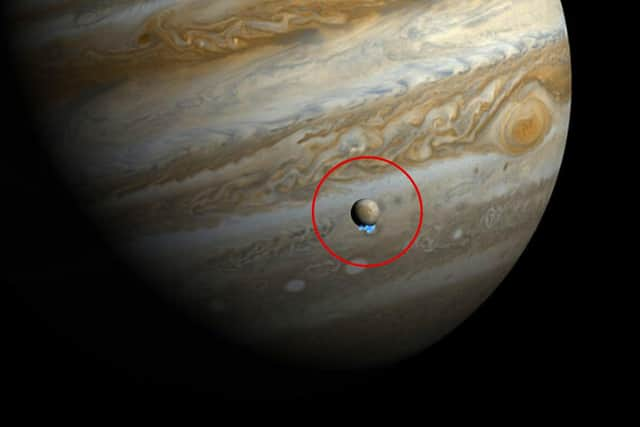Europa: James Webb Space Telescope finds carbon source on Jupiter's moon
and live on Freeview channel 276
Observations from the James Webb Space Telescope have shown that carbon dioxide on one of Jupiter's moons, Europa, comes from within its subsurface ocean.
Europa is a prime target in the search for extraterrestrial life due to its subsurface ocean of salty liquid water.
Advertisement
Hide AdAdvertisement
Hide AdWith the new findings, that come from a pair of independent studies in the journal Science, future missions would assess its potential habitability, depending on its chemistry, including the abundance of biologically essential elements like carbon.


It was previously unclear how the presence of solid carbon dioxide ice on Europa’s surface had originated but researchers, including those from Cornell University in the US, sought to see whether the CO2 was delivered to the moon’s surface by meteorite impacts or through interactions with Jupiter’s sphere of magnetic field around it.
In the new study, scientists analysed data on infrared radiation of CO2 from Europa’s surface obtained using JWST.
One study mapped the CO2 distribution and found its highest amount is in a nearly 1,800-square-kilometre region called Tara Regio. The region is dominated by “chaos terrain” or geologically disrupted resurfaced materials.
Advertisement
Hide AdAdvertisement
Hide Ad“On Earth, life likes chemical diversity – the more diversity, the better. We’re carbon-based life. Understanding the chemistry of Europa’s ocean will help us determine whether it’s hostile to life as we know it, or if it might be a good place for life,” said Geronimo Villanueva of NASA’s Goddard Space Flight Center in Greenbelt, Maryland, lead author of one of two independent papers describing the findings.
Based on the findings, scientists said this CO2 was formed within Europa’s subsurface ocean and brought to the surface on a geologically recent timescale - suggesting that the moon’s subsurface ocean contains carbon, one of the essential ingredients known for the formation of life.
“We now think that we have observational evidence that the carbon we see on Europa’s surface came from the ocean. That's not a trivial thing. Carbon is a biologically essential element,” added Samantha Trumbo of Cornell University in Ithaca, New York, lead author of the second paper analysing these data.
The other study found that CO2 on Europa’s surface is sourced from within and mixed with other compounds. However, neither study could distinguish if there was a non-living or living source creating the carbon dioxide.
Comment Guidelines
National World encourages reader discussion on our stories. User feedback, insights and back-and-forth exchanges add a rich layer of context to reporting. Please review our Community Guidelines before commenting.
